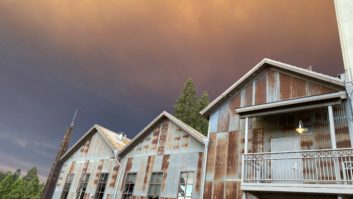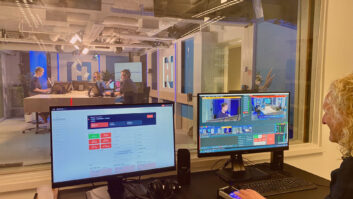Mike Starling Says Nonprofit, Independent Technology R&D Is Vital to Radio’s Longevity
Despite having weathered the advent of TV, 8-tracks, CB radio, cassettes, CDs and satellite radio, radio broadcasting faces unprecedented uncertainty about retaining our primacy as the companion medium at home, at work and in the dashboard. Few will argue there is little risk in losing mindshare and timeshare to podcasting, the death star or emerging wireless internet radio.
We are all yearning for an understanding of what’s next. What can be next? What will be next? What should be next? And how can the radio industry ensure that what should be next, will be?
Vision quest
For radio, the 2,500 stations now on the road to HD Radio represent an inflection point that will make an enormous difference in whether radio will be thriving and how it will be used a decade from today.
At the 2005 Consumer Electronics Show, three emerging audio broadcast technologies were on full display: satellite radio, HD Radio and Internet wireless radio.
In my view, only digital radio offers benefits to both stations and national programmers. For those of us who believe that substantial influence and sustainability results from integrating local and national services, this is extremely good news.
But given the looming choices of satellite, podcasts and Internet radio, complacency with our current broadcast system would be myopic. Every station should have a layered strategy to bolster and maintain radio’s primacy, especially in the captive venue of drive time.
One of the most intriguing facets of the digital age is that digital information is inherently untrustworthy.
No longer can we trust that sound, pictures, text or movies represent what they purport to capture. Whether it’s a National Guard memorandum, a picture of a face on the surface of Mars or the placement of the first down line, we need humans with yardage chains to testify that things are indeed as they appear. The constraints not only of time and space, but of reality itself are being relaxed by information technology.
Some “expert” commentators on the subject of IBOC consistently derided every aspect of the system and ownership, never granting a quarter to the brilliance of Yankee ingenuity at work. They failed to appreciate how the system could – with the help of a best-in-class audio codec – be readily turbocharged to yield tremendous opportunities for new public services and new revenue opportunities to promote sustainability.
Just 18 eighteen months after the codec switch prompted some pundits to declare HD Radio conclusively derailed, both commercial and noncommercial colleagues have rallied around the Ibiquity system and the multicasting future it enables.
Is it not ironic that the unredeeming Howard Stern’s defection to satellite broadcasting for a sum of money unheard of in terrestrial radio has prompted our industry to get serious about both HD Radio and multicasting? The recent, nearly half-billion dollar commitment to HD Radio is the largest technology upgrade in “earth radio” to date.
In the face of subscription dollars wafting up to the “death star,” the hand wringing of old has been left behind. The cackles of “Will it work?” “Is the Ibiquity license fee acceptable?” “How dare the FCC pick a winner!” or “Shouldn’t we only endorse a worldwide standard?” appear to have vaporized as quickly as it took Howard to whisper those two special words “I accept.”
Technology truth-seekers
As many have observed, the promise of what lies ahead often outpaces reality, whether it is flying cars, the paperless office, 3D videophones or “getting on the virtual bus.”
Although the perception of digital reality is fungible, there are immutable laws of physics the human race has yet to surmount – small nuisances like the speed of light, coding delay and disruptive interference from frequency sharing.
Arbitrating among technology experts, who often have disclosed or undisclosed vested interests, is not a new problem. In an earlier era, a Presidential Advisory Group on “Anticipated Advances in Science and Technology” proposed establishing a “Science Court” meticulously to sort scientific facts from the non-scientific issues to ascertain the truth of complex engineering disputes.
Not only has forecasting by technical wizards been seriously deficient, an awareness of fundamental technical realities can escape many brilliant technical minds. A legendary example was De Forest’s inability to grasp that his “Audion tube” could be used as a powerful regenerative amplifier – the missing precursor for launching the entire radio industry.
Throughout the electronic history there have been leaders with technical mastery and a clear vision who realistically understood how the legal, marketplace and technical innovations could align to create valuable new products and services.
Dave Sarnoff and Bill Gates made a lot of their own luck, but much of it grew from clear vision and the relentless passion for seeing their visions become reality.
Missing resources
Once there was an important role for technology research in shaping broadcast media. NBC and CBS Labs shared a multi-decade commitment to innovation and brought us color television, electromagnetic recording, audio processing, electronic newsgathering and a host of operational improvements that made decisive differences in operating budgets.
The FCC itself was once a bastion of unparalleled engineering expertise, making fundamental discoveries about propagation and setting the benchmarks for decades of evolving standards and practices. Eventually, the FCC turned away from a sizable investment in engineering prowess and increasingly became beholden to the assertions of commercial proponents.
In the 1970s and early 1980s the Corporation for Public Broadcasting housed a technology unit under the tutelage of Chief Scientist Phil Rubin and Deputy Chief Rob Bednarek. They did great work spearheading fundamental contributions moving program distribution to satellite technology, improving UHF reception and working toward the All Channel Radio Receiver Act, defeated on the Hill by entrenched AM interests.
Yet, for reasons now lost to us, the CPB shifted focus concurrent with the arrival of the first consumer digital devices – devices that for the first time outpaced “broadcast quality” as the unequaled standard of highest technical fidelity.
More recently, PBS housed the last national broadcast technology lab, the Advanced Television Technology Center (ATTC), which made fundamental contributions to the development, testing and evaluation of competing digital television systems. But, like NBC Labs long ago and CBS Labs in 1986, the ATTC shut its doors in 2003.
Perhaps we radio broadcasters should be content with exploiting the leftover market niches of commercially inspired technologies as best we can. It is fitting that the same Carnegie II Commission which failed to foresee personal computers, CDs and digital broadcasting advocated setting aside a $10 million annual budget for a centralized Research and Development center to “assist the system in taking advantage of new technology to meet public needs.”
As we move forward into the 21st century, we move deeper into knowledge media, with entirely new inflection points ahead. Is radio resigned to exploiting quietly the remnants of initiatives whose inevitable objective is to cannibalize our listenership?
Or might we make path-finding a priority to guide us in evaluating competing options for our technological future? One rooted in both public service and market sustainability?
The combination of the service opportunities of emerging technologies, the absence of public service objectives in most commercial efforts and the innumerable inflection points ahead set stage for something new.
Fact-based technical knowledge, public service objectives and marketplace fundamentals are means as well as ends. The rigor to attain greater use and enjoyment of radio is at hand, if we act decisively to explore a future that might and should be.
It is time for a lasting, public service-driven, radio broadcast technology research center. Its activities would be dedicated to the proposition that fact-based technical knowledge and relentless focus on listener engagement are both means and ends. Such a center should focus zealously – first, last and always – on the user’s experience.
Maintaining listener focus would be guarded by independence, and being decidedly non-profit in nature and affiliations. History has shown that the inevitable pressure to support products, services and intellectual property of parents and partners would otherwise undermine strategic objectives.
Moreover, such a center should be insulated from non-mission budgetary pressures by operating under an endowment, contributed by organizations and individuals committed to re-inventing a dynamic future for the original wireless medium.
The rigor to attain greater use and enjoyment of “earth radio” is at hand – if we act to shape a future that might and should be.











